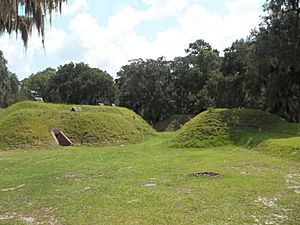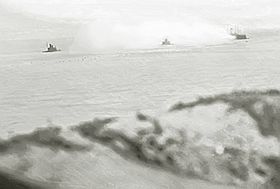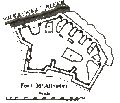Battle of Fort McAllister (1863) facts for kids
Quick facts for kids Naval Attacks on Fort McAllister |
|||||||
|---|---|---|---|---|---|---|---|
| Part of the American Civil War | |||||||
 GA Richmond Hill Fort McAllister inside |
|||||||
|
|||||||
| Belligerents | |||||||
| Commanders and leaders | |||||||
| Capt. Percival Drayton Cdr. John L. Worden Cdr. Daniel Ammen |
Maj. John B. Gallie † George Wayne Anderson |
||||||
| Units involved | |||||||
| U.S.S Montauk U.S.S Patapsco U.S.S Passaic U.S.S Nahant |
Fort McAllister Garrison- Emmett Rifles Georgia Sharpshooters Republican Blues Chatham Artillery |
||||||
| Casualties and losses | |||||||
| unknown | unknown | ||||||
The Naval Attacks on Fort McAllister were a series of battles during the American Civil War. These fights happened from January 27 to March 3, 1863. They took place in Bryan County, Georgia. The Union Navy wanted to test their new ironclad ships called monitors. They planned to attack Fort McAllister first. This would help them prepare for a bigger attack on Charleston, South Carolina.
Contents
Fort McAllister: A Stronghold on the River
Fort McAllister was a small fort made of earth. It was built on Genesis Point. The fort had several large cannons. These guns protected the Great Ogeechee River. This river was an important path south of Savannah, Georgia.
The fort was made stronger over time. More cannons were added. Special walls called traverses were built. These protected soldiers from enemy fire. Bombproofs were also added. These were safe shelters from explosions. The river also had defenses. These included underwater obstacles and mines, which were called "torpedoes" back then.
Early Attempts to Capture the Fort
In July 1862, a Confederate ship called the Nashville sailed up the river. It was trying to escape Union ships. The Nashville got stuck near the fort.
Rear Adm. Samuel F. Du Pont was a Union commander. He learned the Nashville was trapped. He ordered Commander Charles Steedman to attack the fort. Steedman's goal was to destroy the fort if possible.
At this time, Captain Alfred L. Hartridge led the fort's soldiers. The fort had six main cannons. On July 29, Steedman led four wooden gunboats. These were the USS Paul Jones, Unadilla, Huron, and Madgie. They fought the fort for 90 minutes. Steedman realized that getting closer would cause too many losses. So, he pulled his ships back.
In August, a new 8-inch cannon was added to the fort. New soldiers, the Emmett Rifles and the Republican Blues, took over. On November 19, Union gunboats USS Wissahickon and Dawn attacked again. They were joined by a mortar schooner.
The fort waited until the Union ships came closer. When the ships were about 3,000 yards away, the fort opened fire. They hit the Wissahickon below the waterline. The Union ships then left. The fort had only minor damage. Only three soldiers were slightly hurt.
First Monitor Attacks
Admiral Du Pont sent an ironclad ship to capture the fort. He also wanted to sink the Nashville. This attack would be the first test for the new Passaic class monitors. These ships had a huge 15-inch Dahlgren cannon. This was the heaviest cannon on a warship at that time. Each monitor also had an 11-inch Dahlgren gun.
On January 27, 1863, the monitor USS Montauk attacked. Three gunboats and a mortar schooner helped. Commander John L. Worden led the Montauk. He shelled the fort for five hours. The Montauk fired from about 1,500 to 1,800 yards away. Its shells tore up the fort's walls. But they caused no lasting damage or deaths. The fort's cannons hit the Montauk thirteen times. These hits only dented the ship's armor. The fort's defenders simply fixed the damage overnight.
On February 1, Commander Worden tried again. Union scouts had removed some mines from the river. This allowed the ships to get closer. The Montauk fired for another five hours. This time, it was only 600 yards away. The fort's commander, Major John B. Gallie, was killed. Seven other soldiers were wounded. Major George Wayne Anderson took command of the fort. The Montauk was hit 48 times. Its gun turret even got stuck for a while. After this, the Confederates added nine more mines to the river.
The Nashville is Destroyed
The Nashville could not get past the Union ships. So, it was sold and became an armed ship called the Rattlesnake. Captain Thomas H. Baker tried to sail it out to sea on February 27. But a Union ship stopped him. The Rattlesnake then ran aground (got stuck) upriver from the fort.
The next morning, Commander Worden anchored the Montauk about 1,200 yards from the fort. It was also about the same distance from the stuck Rattlesnake. The Montauk began firing at the stranded ship. The fort fired at the Montauk to try and distract it. After only a few minutes, the Montauk's fifth shot hit the Rattlesnake. This and other shells caused a fire. Soon, explosions destroyed the ship. The Montauk had fired fourteen shots in total.
As the Montauk sailed back down the river, it hit a mine. Commander Worden quickly steered the ship onto a mud bank. The low tide helped seal the leak. This allowed them to make temporary repairs. When the tide rose, the ship floated again. The Montauk was later sent to Port Royal for full repairs.
After the first attacks, Admiral Du Pont realized something important. One monitor could not fire fast enough to defeat the earth fort. So, he ordered three more ironclads to attack. These were the USS Patapsco, Passaic, and Nahant. They would test their guns and practice firing. The Montauk was kept in reserve. Captain Percival Drayton of the Passaic would lead this attack.
The fort was made even stronger for this attack. A new 10-inch cannon was added. The fort now had many different cannons. These included a 32-pounder rifle, a 10-inch cannon, an 8-inch cannon, and a 42-pounder smoothbore. There were also three 32-pounder smoothbores (one for "hot shot"). A 10-inch mortar was in a connected part of the fort. Also, several sharpshooters hid in the marsh. They aimed at the monitors from the other side of the river.
On March 3, 1863, the three new ironclads began an eight-hour attack. Five gunboats and three mortar schooners supported them. These ships stayed out of the fort's range. Several steamers with the 47th New York Infantry waited nearby. They planned to take over the fort if it was defeated.
The monitors anchored about 1,200 yards from the fort. They started shelling. The fort tried to hit the ships' gun ports when the turrets turned to fire. The bombardment knocked out the 8-inch cannon. It also tore big holes in the fort's front. For a while, only the 10-inch cannon could fire. But other guns were soon put back into service.
The Confederate sharpshooters in the marsh fired at Captain Drayton and Commander Miller. They had come out on the deck of the Passaic. Neither was badly hurt. They quickly went back inside the ship. The Union ships fired Grapeshot into the marsh to stop the sharpshooting.
The ironclads were damaged mostly by their own cannons. However, the fort's 10-inch mortar caused serious damage to the Passaic. The mortar commander, Captain Robert Martin, used a clever trick. He filled his mortar shells with sand instead of gunpowder. This made them heavier. When a shell hit the Passaic's thin deck, it partly broke through. It was stopped only by a strong beam inside the ship.
As the tide went out and night came, the Union ships left. Captain Drayton tried to stop the Confederates from repairing the fort. He ordered 13-inch mortar fire all night. This stopped enslaved people from working. But Confederate soldiers still made repairs. By the next afternoon, the damage was fixed. The fort's mascot, Tom Cat, was reported lost to General Beauregard.
The attack on the fort failed. No more naval attacks were ordered against it. The battles showed important weaknesses of the monitors. Efforts would be made to fix these problems.
What Was Learned from the Battles?
The first tests of the 15-inch Dahlgren gun and single-turret monitors against Fort McAllister taught the Union Navy many lessons:
- The large cannons fired very slowly. This gave defenders time to fire back. They could also take cover. The fort's cannons fired much faster. Even several monitors firing at once could not stop the fort's guns.
- The monitors' turrets sometimes got stuck. Other mechanical problems could also stop their guns from working.
- When shells hit the armor, pieces of metal could break off inside. These flying pieces were dangerous to the crew.
- The monitors' thin decks were weak. They could be hit by shells fired from above, like those from heavy mortars.
- Earth forts could be fixed quickly. Damage could be repaired overnight or the next day. This meant the fort could be ready to fight again.
- Long-range mortar fire against a fort was not accurate enough to be useful.
- To stop repairs, continuous fire would be needed all night.
- Obstacles and mines in the river stopped ships. Even if monitors were safe from the fort's guns, they couldn't pass.
- Forts made of sand held up well to shelling. Forts made of mud did not.
- Well-built walls and shelters protected the fort. They made it hard to attack from the side.
Admiral Du Pont tried to fix these problems. He ordered more armor for the decks. He tried to create a device to clear mines from the front of his ships. He also added as many ironclads as possible to attacks. This was to increase the total number of shots fired.
Admiral Du Pont warned that monitors might not be able to defeat earth forts. But his warnings were not fully listened to. He prepared for the attack on Charleston harbor. That attack failed. The ironclad USS Keokuk was lost. Du Pont took responsibility for the failure and resigned.
Fort McAllister was never captured by naval attacks. It was finally taken by soldiers at the end of Sherman's March to the Sea in December 1864.
Images for kids











